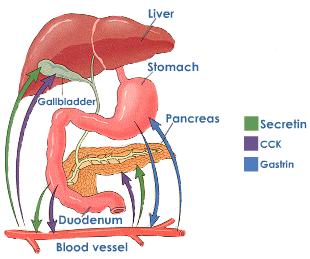salivari glands are found on thi lining of buccal cavity.these are tiny salivari glands.there are more three large salivary glands which are compound racemose in nature.they are;
parotid
gland: these are largest salivary glands situated on either side of face just
below external auditory meatus.each gland open into mouth by parotid duct(stenson's duct).
submandibular
gland: they lie on each side of face under the angle of jaw.the two
submandibular duct opens into mouth cavity on each side of frenulum of tongue through wharton's duct.
sublingual
ducts: these glands lie below the tongue .they have numerous small ducts(ducts of rivinus),opening in the floor of mouth.
The glands are highly
branched and consists of a number of lobules made up of small alveoli lined
with secretory cells.the glands are supplied with parasympathetic and
sympathetie nerve fibres.
the
secretion of salivary gland is called saliva.it is alkaline,close to neutral
value.it contains water,minerals,salts,mucus,lysozymes,immunoglobins,blood
clotting factors,lysosome,maltase,lipase,calatase,protease etc.
The
Pancreas lies ventral to the stomach and has both endocrine and exocrine
function. so it is called mixed gland or heterocrine gland.exocrine part of
pancrease contains pancreatic acini which secretes pancreatic juice and enzymes
and pour into pancreatic duct, which merges with hepatic duct from the liver to
form common hepato-pancreatic that enters the duodenum throuch spinchter of
oddi. Pancreatic juice (enzymes) complete the digestion of carbohydrates and
proteins and initiate the digestion of lipids.Trypsin, carboxypeptidaze and
chymotrypsin digest protein into lower molecular weight containing peptide and
amino acids.Lipases convert triglycerides into
glycerol and free fatty acids. Amylase converts polysaccharides(higher
sugar) into disaccharides and monosaccharides.The pancreas also secretes
bicarbonate hco3-- ions that help neutralize the acidic food residue coming
from the stomach. Bicarbonate raises the pH from 2 to 7 for pancreatic enzymes
to work.
function:
1.hormone
insulin produced by pancreatic islets help in metabolism of
2.carbohydrate.pancreatic uice being acidic increase the ph of acidic chyme in
small intestine.
3.pancreatic
juice help in digestion of proteins,carbohydrates and fats.
The liver,
the largest organ in mammalian body and also the largest gland. it lies under the diaphragm in abdominal cavity. In
the liver millions of specialized cells i.e hepatic cells or hepatocytes .
in liver there is process of removal of amino
acids from organic compounds. There occurs urea formation from proteins and
conversion of excess amino acids into urea to decrease body level of ammonia.
There occurs manufacture of most of
plasma proteins, formation of fetal erythrocytes, and destruction of worn out
erhythrocytes and synthesis of blood clotting agents prothrombin and Fibrinogin
from amino acids.liver also synthesize non essential ammino acids.
there
occurs conversion of galactose and fructose to glucose, oxidation of fatty
acids , formation of lipoproteins, cholesterol and phospholipids (essential
cell membrane components). there occurs conversion of carbohydrates and
proteins into fat. liver modify waste products, toxic drugs and poisons
(detoxification).liver synthesize vitamin-a from carotene. liver along with kidney activate
vitamin-d.It maintain the body temperature by increasing the temperature of
blood passing through it.as it perform many metabolic activity,it is the
largest heat producing organ of body.in liver,occurs the manufacture of salts
which are used in the small intestine for emulsification and absorption of
simple fats, lipid and lipoprotein.Liver stores glucose in the form of glycogen
and by the help of insulin hormone and enzymes, converts glycogen back into
glucose when body needs it. Liver also stores fat soluble vitamins (A, D, E and
K) and minerals such as iron. Liver can also store fats and amino acids and
convert them into usable glucose as required. liver can store vitamins and
minerals for six months.liver is also haemopoetic organ and site of
phagosytosis.
Gall
bladder is a small organ near the liver. Gall bladder stores greenish fluid
called bile that the hepatic cells
continuously produce. Bile is alkaline
and contains pigments, cholesterol, lecithin, mucin, bilirubin and bile salts
that act as deterents to emulsify fats from them into droplets suspended in
water and aid in fat digestion and absorption.
Gastric
glands
gastric glands are found in the mucosa of
stomach wall.they are numerous,simple or branched and microscopic.they are of
three types :
1.cardiac
gland: they secrete mucus and found in cardiac stomach.
2.pyloric
gland: they secrete mucus and found in pyloric stomach.
3.fundic
gland: they are found in findic region of stomach and contaon 4 cells:
- peptic/zymogen cells: secrete pepsinogen,prorenin,lipase.
- oxyntic cells: they secrete hcl and called parietal cells.
- goblet cells: they secrete mucus
- argentafin cells : they secrete gastric hormone
Intestinal glands: they are fund in lining of
intestine and are of two types:
*crypts of
lieberkuhn: multicellular gland,tubullar,produce enzyme and mucus.
*brunner's
gland : compound,tubular gland,found in submucosa of duodenum,produce alkaline
watery juice.
the
secretion of intestinal gland is collectively called succus entericus.



Thanks for your Post; it really provides me lot information regarding my work.
ReplyDeleteA good comment can be written only after going through the content written in the blog. This is highly required to know what the blog belongs to and what is it telling. Comment should be relevant to the blog content or can also be some other information related to the topic illustrated in the blog. It should not be like starting a new discussion there in the middle of the topic related discussion.
ReplyDelete